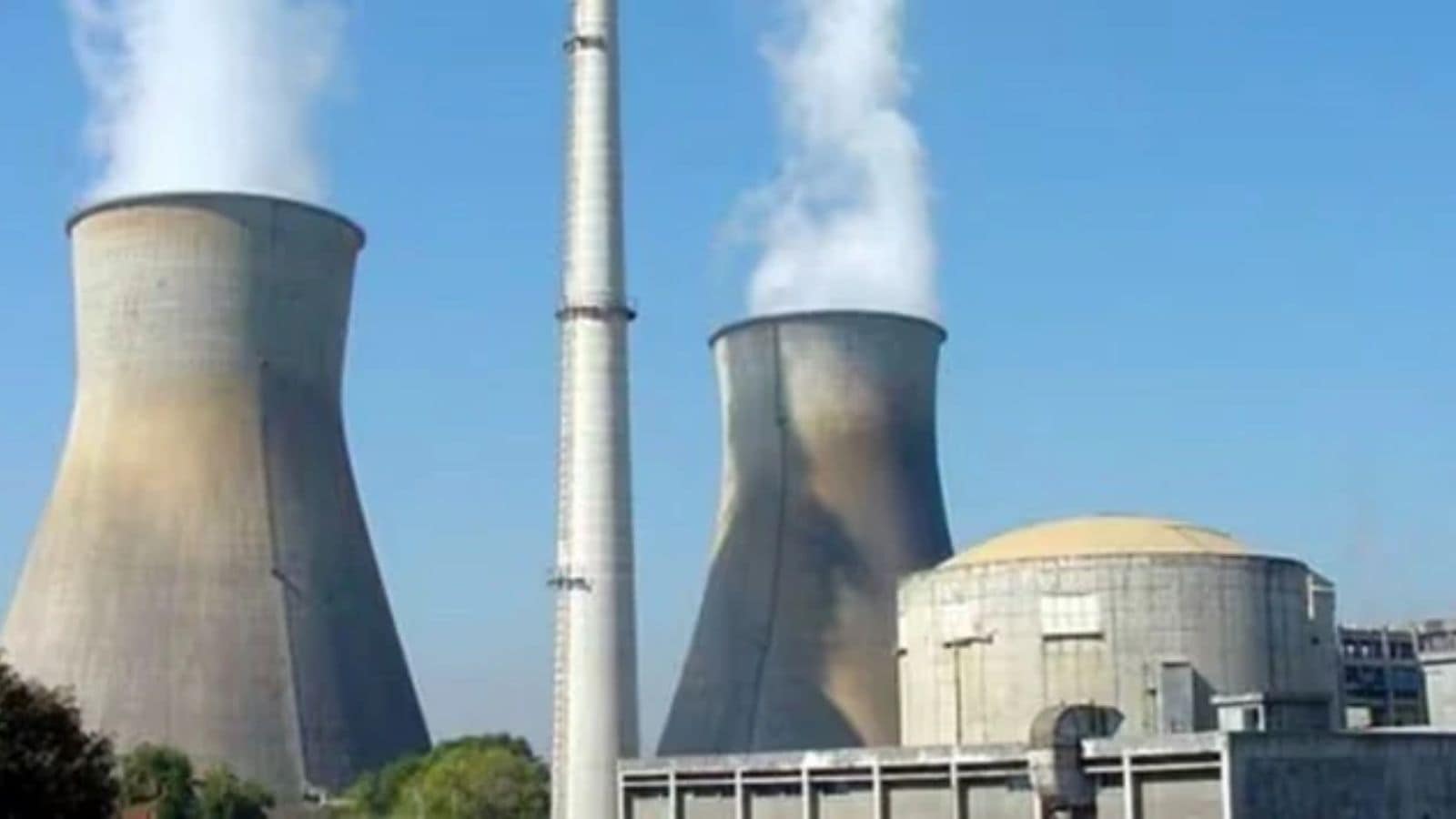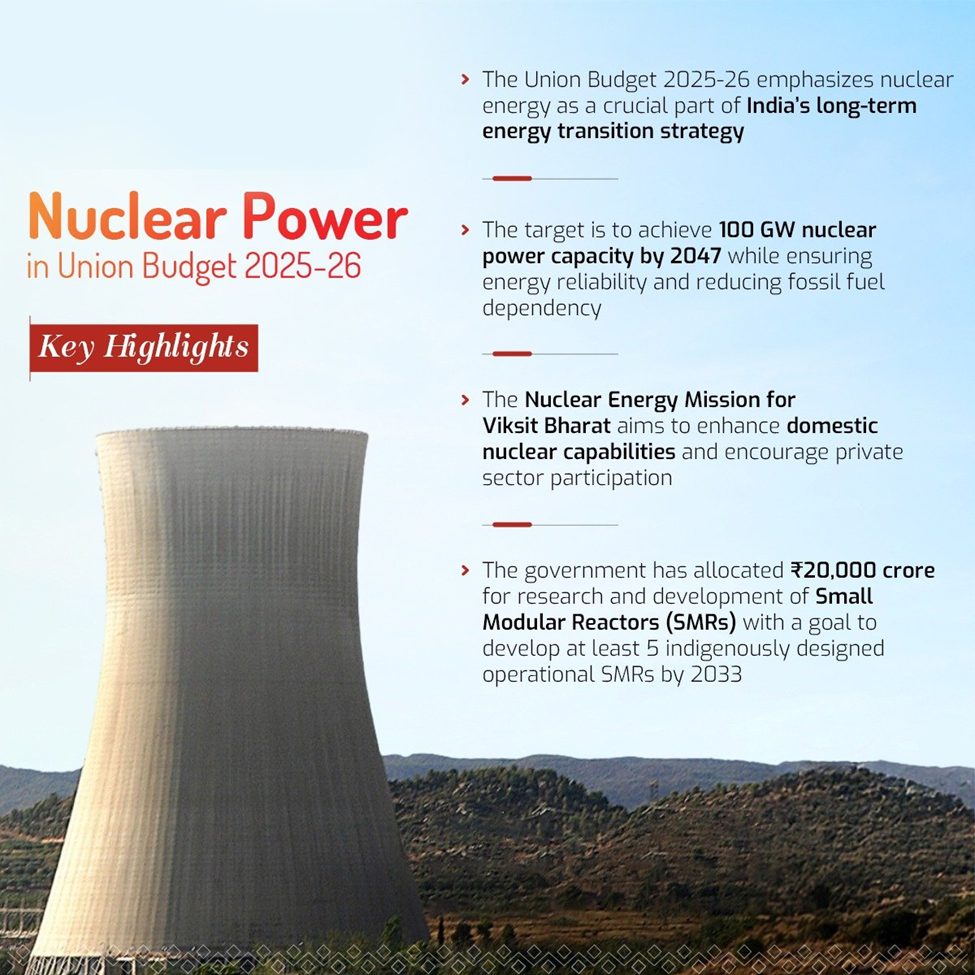Nuclear energy is one of the most powerful and reliable sources of electricity in the world. Unlike solar and wind power, which depend on the weather, nuclear power can provide steady and continuous electricity — known as base-load power. It also produces almost no carbon emissions, making it a clean energy source that can help fight climate change.
- India’s Union Budget for 2025–26 marked a turning point in nuclear energy journey of India. The government has set a bold new target — to achieve 100 GW of nuclear power capacity by 2047, a massive leap from the current 8.18 GW. This aligns with two national goals: becoming a developed country (Viksit Bharat) by 2047 and achieving net-zero emissions by 2070.
- To support this target, the government also launched the Nuclear Energy Mission, with a special allocation of ₹20,000 crore to develop at least five indigenously designed Small Modular Reactors (SMRs) by 2033. However, to achieve these goals, India must open the nuclear sector — so far a government monopoly — to private and foreign participation. This will need major legal, financial, and regulatory changes.
About India’s Nuclear Journey:
India’s nuclear programme began early:
- In 1956, India set up Asia’s first research reactor, Apsara.
- In 1963, it started work on the Tarapur power reactors.
- In 1954, Dr. Homi Bhabha, the father of India’s nuclear programme, had set a goal of generating 8 GW of nuclear power by 1980.
However, India’s nuclear ambitions were faced with many roadblocks:
- After the 1962 war with China, India became more focused on strategic nuclear capability.
- India refused to sign the Nuclear Non-Proliferation Treaty (NPT) in 1968.
- In 1974, it conducted a Peaceful Nuclear Explosion (PNE).
Consequently, India was cut off from global nuclear cooperation. It could no longer import nuclear technology or fuel easily. These restrictions slowed down progress. The nuclear power target was pushed to 10 GW by 2000.
India then worked on indigenizing its nuclear technology. It developed the 220 MW Pressurised Heavy Water Reactor (PHWR), which used natural uranium instead of imported fuel. These were set up in Rajasthan, Narora, Kaiga, and Kakrapar.
Later, India upgraded to 540 MW reactors at Tarapur (2005-06) and further to 700 MW, with two units at Kakrapar starting in 2024.
After the 1998 nuclear tests, India engaged in serious talks with the U.S. and other global powers. In 2008, it got a special waiver from the Nuclear Suppliers Group (NSG). This allowed India to import nuclear fuel and technology again.
· But a new challenge emerged — the Civil Liability for Nuclear Damage Act (CLNDA), 2010. This law scared away many foreign suppliers due to its strict liability clauses.
· Only Russia, which signed a deal in 1988 (before CLNDA), is currently working with India at Kudankulam, where it is building six VVER-1000 reactors.
Significance of Nuclear Energy for India:
To become a developed country by 2047, India will need strong economic growth. The size of the economy must grow from the current $4 trillion to over $35 trillion. At the same time, the average income per person needs to rise from around $2,800 to $22,000. This kind of economic transformation will also require a massive increase in energy use.
There is a direct link between economic growth and energy consumption. In 2022:
· India’s per capita electricity use was 1,208 kWh.
· China’s was 4,600 kWh.
· The U.S.’s was 12,500 kWh.
India currently has 480 GW of installed capacity which is fulfilled through fossil fuels and renewables. To meet future demand, India needs to grow its installed capacity five times, especially due to rising urbanization and population.
However, solar, wind, and small hydro are intermittent sources. In 2024:
· Renewables made up 50% of installed capacity but generated only 240 TWh out of 2030 TWh of total electricity.
· Coal-fired power plants contributed 75% of total electricity generation.
At COP26 (Glasgow, 2021), India committed to:
· Net-zero emissions by 2070.
· 500 GW of non-fossil capacity by 2030.
· Meeting 50% of energy needs from renewables.
· Cutting carbon intensity by 45% over 2005 levels.
Why Nuclear Energy Is the Answer?
Even with better investments in batteries and energy storage, renewables can meet only about 20-25% of energy demand, even with investment in battery storage. So, nuclear energy is the only reliable, low-carbon option that can deliver base-load power at large scale.
A Global Push for Nuclear Power
· At COP28 (Dubai, 2023), countries signed a Declaration to Triple Nuclear Energy.
· The IAEA and World Bank agreed to support nuclear energy in developing countries.
· World Bank President Ajay Banga noted that nuclear energy is essential for “building modern economies” because it delivers base load power.
The Three-Track Strategy
1. Standardising Small Modular Reactors (SMRs)
India will use the proven 220 MW PHWR design to develop SMRs. These could replace the 100+ GW of captive coal plants currently in use by industries. SMRs are smaller, safer, and faster to build.
2. Scaling Up 700 MW Reactors
India aims to expand the 700 MW PHWR programme led by NPCIL. This requires:
· Faster land acquisition,
· Easier licensing processes,
· Stronger local supply chains.
3. Reviving Foreign Collaborations
India will accelerate talks with France and the U.S., which have been slow for the last 15 years. Foreign partnerships are essential to scale up capacity.
Legal and Policy Reforms
Atomic Energy Act, 1962
Under this Act, only the government can operate nuclear plants. The Nuclear Power Corporation of India Limited (NPCIL) is the only public sector company building and operating nuclear plants. But to achieve 100 GW, private participation is essential.
Key issues under consideration include:
· Whether private companies can have majority ownership
· Who will control the nuclear island of the reactor
· Who ensures fuel supply and waste disposal
Private players like Tata, Adani, Reliance, and Vedanta have shown interest. However, this will require clear amendments to the Act.
CLNDA, 2010
This law made suppliers liable for nuclear accidents along with operators. This has discouraged many global suppliers. India is now considering amendments to the liability clause to bring in international players.
Dispute Resolution and Tariffs
Tariffs for nuclear electricity are currently set under the Atomic Energy Act. But a dispute between NPCIL and Gujarat Urja Vikas Nigam raised confusion between the roles of the Atomic Energy Act and the Electricity Act. With private players entering, tariffs may have to follow the levelised cost of energy (LCOE) model used for thermal, solar and wind energy.
Independent Regulator
The Atomic Energy Regulatory Board (AERB) currently reports to the Department of Atomic Energy. Although it is autonomous, it is not a legal entity. A draft Bill in 2011 to establish an independent regulator lapsed. With private players entering the sector, there is a strong need for a statutory, independent regulator.
· Introducing viability gap funding for nuclear projects
Current Progress
· Two 700 MW PHWRs are already operational at Kakrapar
· A major project at Mahi Banswara (Rajasthan) will see four 700 MW reactors built by an NPCIL-NTPC joint venture
· Land acquisition is ongoing, and the first reactor will take about seven years after construction starts
· A similar JV is being considered with the Rural Electrification Corporation (REC)
Conclusion:
India has a long and respected history in nuclear energy. The new targets set for 2047 show the government's seriousness in making nuclear energy a key pillar of its development and climate goals. To reach this target, major reforms, private sector participation, and global partnerships are necessary. With the right mix of policy action, financial planning and strong execution, India can make nuclear energy a central part of its clean energy future.
| Main question: In the context of India’s net-zero commitment and rising energy demand, examine the role of nuclear power in ensuring clean base-load energy. Also discuss the financial and environmental concerns associated with its expansion. |








